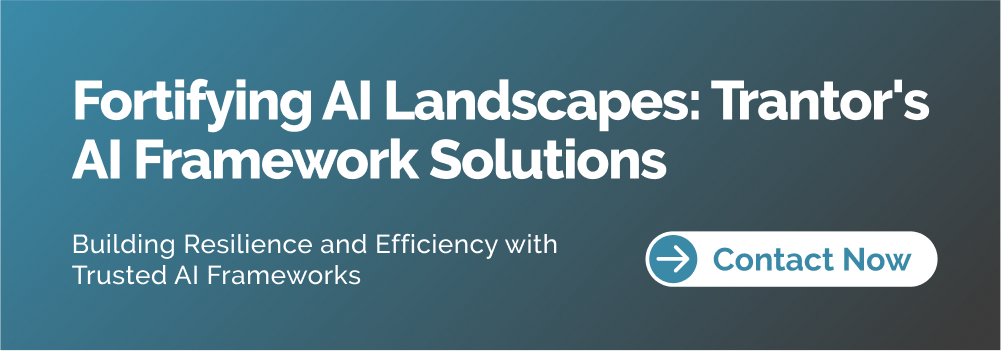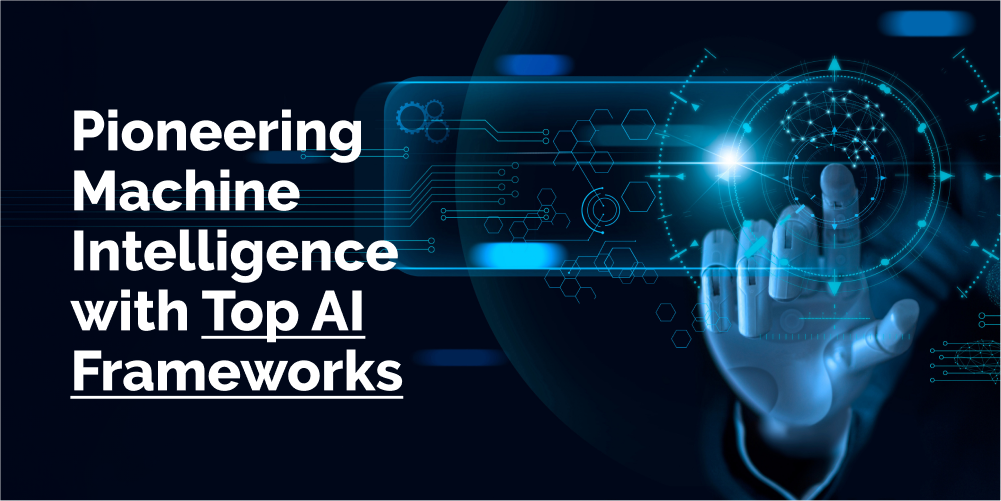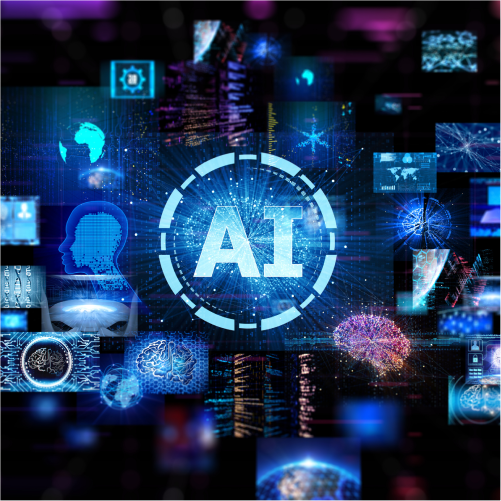Artificial Intelligence, zBlog
2025’s Top AI Frameworks: Pioneering the Future of Machine Intelligence
Team Trantor | Updated: May 8, 2024
As we forge ahead into the ever-evolving landscape of artificial intelligence (AI), the frameworks that underpin this transformative technology continue to push the boundaries of what’s possible. In 2025, a multitude of AI frameworks have emerged, each offering unique capabilities and innovative approaches to tackling the complexities of machine intelligence. From streamlining the development process to enabling cutting-edge applications, these frameworks are paving the way for a future where AI permeates every aspect of our lives.
In this comprehensive blog post, we’ll explore some of the top AI frameworks that are pioneering the future of machine intelligence in 2025. Buckle up as we delve into the exciting world of AI and uncover the powerful tools driving the next wave of technological advancements.
TensorFlow 3.0: The Evolution of a Titan

Developed by Google Brain, TensorFlow has long been a powerhouse in the realm of AI frameworks, and its latest iteration, TensorFlow 3.0, is taking machine learning to new heights. With a focus on enhancing usability, performance, and scalability, this framework continues to push the boundaries of what’s possible.
One of the standout features of TensorFlow 3.0 is its improved support for distributed training and deployment. By leveraging advanced techniques like model parallelism and pipelining, this framework enables researchers and developers to efficiently train and deploy large-scale models across multiple GPUs, TPUs, and even clusters of machines. This capability is crucial for tackling complex tasks that require vast amounts of computational power, such as natural language processing (NLP) and computer vision.
Additionally, TensorFlow 3.0 introduces a revamped ecosystem of libraries and tools, including TensorFlow Extended (TFX) for end-to-end machine learning pipelines, TensorFlow Federated for privacy-preserving collaborative learning, and TensorFlow Quantum for exploring quantum machine learning algorithms. These additions further solidify TensorFlow’s position as a comprehensive and versatile AI framework, catering to a wide range of applications and emerging technologies.
PyTorch 2.0: Accelerating AI Innovation

PyTorch, the open-source AI framework developed by Facebook’s AI Research lab, has gained significant traction in recent years due to its intuitive and dynamic nature. With the release of PyTorch 2.0, this framework continues to push the boundaries of AI development, offering a streamlined and efficient workflow for researchers and practitioners alike.
One of the key highlights of PyTorch 2.0 is its enhanced support for production-ready deployment. The framework now includes robust tools for model optimization, quantization, and deployment on a variety of hardware platforms, including edge devices and mobile systems. This feature empowers developers to seamlessly transition their AI models from research and development to real-world applications, enabling a smoother and more efficient deployment process.
Furthermore, PyTorch 2.0 introduces significant improvements in its automatic differentiation engine, enabling faster and more memory-efficient training of deep learning models. This enhancement is particularly beneficial for tasks that involve large datasets or complex architectures, such as natural language processing and computer vision.
JAX: Accelerating Machine Learning with Functional Programming

JAX, short for “Composable Transformations of Python+NumPy Programs,” is a relatively new entrant in the AI framework landscape, but its unique approach to machine learning has already garnered significant attention. Developed by Google’s Brain team, JAX leverages the power of functional programming and just-in-time (JIT) compilation to provide an efficient and flexible environment for building and deploying machine learning models.
One of the standout features of JAX is its seamless integration with hardware accelerators like GPUs and TPUs. By leveraging XLA (Accelerated Linear Algebra), JAX can automatically compile and optimize numerical computations, enabling lightning-fast execution on a variety of hardware platforms. This capability is particularly valuable for computationally intensive tasks such as deep learning and scientific computing.
Moreover, JAX’s functional programming paradigm promotes code modularity, reusability, and composability, making it easier to develop and maintain complex machine-learning pipelines. Its library of high-performance primitives and composable transformations further streamlines the development process, allowing researchers and developers to focus on their core algorithms and models.
LightningAI: Simplifying Deep Learning Workflows

LightningAI, formerly known as PyTorch Lightning, is a lightweight Python-based AI framework that aims to simplify the development of deep learning models. Built on top of PyTorch, LightningAI abstracts away many of the complexities associated with training and deploying deep learning models, enabling researchers and developers to focus on their core algorithms and architectures.
One of the key strengths of LightningAI is its emphasis on reproducibility and scalability. The framework provides a standardized and modular structure for organizing deep learning projects, making it easier to collaborate, share, and reproduce experiments. Additionally, LightningAI offers built-in support for distributed training and mixed-precision computation, allowing developers to efficiently scale their models across multiple GPUs or TPUs.
Another noteworthy feature of LightningAI is its extensive ecosystem of plugins and integrations. The framework seamlessly integrates with popular machine learning libraries and tools, such as Weights & Biases for experiment tracking, Tensorboard for visualization, and Hugging Face Transformers for natural language processing tasks. This rich ecosystem empowers developers to leverage the best tools and libraries available, streamlining their workflows and enhancing productivity.
TensorFlow Lite: AI at the Edge

As the demand for edge computing and Internet of Things (IoT) applications continues to grow, the need for efficient and lightweight AI frameworks has become increasingly important. TensorFlow Lite, a lightweight version of Google’s TensorFlow framework, addresses this need by enabling the deployment of machine learning models on resource-constrained devices such as smartphones, embedded systems, and IoT devices.
One of the key advantages of TensorFlow Lite is its optimized runtime and model compression capabilities. The framework employs advanced techniques like quantization and pruning to reduce the size and computational requirements of machine-learning models, making them suitable for deployment on low-power devices with limited memory and processing resources.
Moreover, TensorFlow Lite supports a wide range of hardware architectures, including ARM, x86, and various embedded platforms, ensuring compatibility and portability across a diverse range of devices. This versatility allows developers to leverage the power of AI in a variety of applications, from smart home assistants and wearable devices to industrial automation and robotics.
Apache MXNet: Scalable and Flexible Deep Learning

Apache MXNet is an open-source deep-learning framework that has gained significant traction in both academia and industry due to its scalability, flexibility, and support for a wide range of programming languages. Developed by a diverse community of contributors, MXNet offers a powerful and efficient platform for building and deploying machine learning models at scale.
One of the standout features of MXNet is its ability to seamlessly scale across multiple GPUs and distributed computing environments. The framework leverages advanced techniques like parameter server and data parallelism to enable efficient training and deployment of deep learning models on large-scale datasets and compute clusters.
Furthermore, MXNet’s language-agnostic design allows developers to leverage the framework using a variety of programming languages, including Python, R, Julia, and more. This flexibility caters to the diverse needs and preferences of the machine learning community, fostering collaboration and enabling a wider range of applications.
Ray: Distributed AI Simplified

Ray is a powerful and innovative distributed computing framework that simplifies the development and deployment of distributed applications, including machine learning and AI models. Developed by the team at Anyscale, Ray provides a unified and scalable abstraction for building and scaling distributed systems, making it easier to leverage the power of parallel and distributed computing.
One of the key strengths of Ray is its ability to seamlessly scale from a single machine to a large-scale cluster, without requiring significant changes to the underlying code. This scalability is achieved through Ray’s actor model, which enables efficient and fault-tolerant distributed execution of tasks and stateful computations.
Additionally, Ray offers a rich ecosystem of libraries and tools for various AI and machine learning tasks, including reinforcement learning (RLlib), hyperparameter tuning (Tune), and distributed model training (RayTrain). These libraries leverage Ray’s distributed computing capabilities to accelerate and scale machine learning workflows, enabling researchers and developers to tackle complex problems with ease.
Ethical AI Frameworks: Prioritizing Responsible Development

As AI technologies continue to permeate various aspects of our lives, the importance of ethical and responsible development has become paramount. In 2025, several frameworks have emerged to address these crucial considerations, ensuring that AI systems are developed and deployed with fairness, accountability, and transparency in mind.
One notable example is the AI Fairness 360 (AIF360) toolkit, developed by IBM in collaboration with academia and industry partners. AIF360 provides a comprehensive set of metrics and algorithms for detecting and mitigating bias and discrimination in machine learning models. By leveraging this toolkit, developers can assess the fairness of their AI systems and implement appropriate mitigation strategies, ensuring that the models are free from unintended biases and promote equitable outcomes.
Another prominent framework in the realm of ethical AI is the Ethical AI Labeling (EAIL) framework, pioneered by researchers at Stanford University. EAIL focuses on enhancing the transparency and accountability of AI systems by providing a structured approach to labeling and documenting the ethical considerations and potential impacts of AI models. This framework enables developers and stakeholders to clearly communicate the ethical implications of their AI solutions, fostering trust and facilitating informed decision-making.
Furthermore, the Responsible AI Toolbox, developed by Microsoft, offers a comprehensive set of tools and resources for embedding ethical principles and practices throughout the AI development lifecycle. This toolbox includes guidance on ethical data practices, model interpretability, and fairness assessments, empowering developers to proactively address ethical concerns and ensure the responsible deployment of AI technologies.
As the adoption of AI continues to accelerate, frameworks like these will play a crucial role in promoting ethical and responsible development practices, ensuring that the benefits of AI are realized while mitigating potential risks and unintended consequences.
The Future of AI Frameworks: Embracing Innovation and Collaboration

The AI framework landscape is constantly evolving, driven by cutting-edge research, technological advancements, and the ever-increasing demands of real-world applications. As we look to the future, several emerging trends and areas of focus are shaping the next generation of AI frameworks:
- Efficient and Sustainable AI: With the growing emphasis on environmental sustainability and energy efficiency, AI frameworks are increasingly incorporating techniques for reducing the computational and energy requirements of training and deploying machine learning models. This includes advancements in areas such as model compression, quantization, and hardware-aware optimization.
- AI for Science and Interdisciplinary Applications: AI frameworks are expanding their reach beyond traditional domains, enabling researchers and scientists to leverage machine learning techniques in fields like biology, chemistry, physics, and environmental sciences. These interdisciplinary applications require frameworks that can handle complex data modalities and address domain-specific challenges.
- Trustworthy and Explainable AI: As AI systems become more pervasive in critical decision-making processes, there is a growing demand for trustworthy and explainable AI frameworks. These frameworks prioritize transparency, interpretability, and robustness, enabling stakeholders to understand and scrutinize the decision-making processes of AI models.
- Democratization of AI Development: Lowering the barriers to entry for AI development is a key focus area for many framework developers. This involves simplifying the development process, providing user-friendly interfaces, and offering comprehensive documentation and educational resources, making it easier for individuals and organizations with varying levels of expertise to leverage the power of AI.
- Collaborative and Open-Source Development: The success of AI frameworks heavily relies on collaborative and open-source development practices. By fostering a vibrant and inclusive community of contributors, researchers, and developers, AI frameworks can benefit from diverse perspectives, accelerate innovation, and ensure long-term sustainability and relevance.
As we navigate the exciting and rapidly evolving landscape of AI frameworks, it is clear that innovation, collaboration, and a commitment to ethical and responsible development will be paramount in shaping the future of machine intelligence. By embracing these principles and leveraging the power of cutting-edge frameworks, we can unlock new frontiers of possibility and harness the transformative potential of AI for the betterment of society.
Trantor is at the forefront of this innovation, combining state-of-the-art Artificial Intelligence with cutting-edge automation solutions and robotic process automation (RPA) solutions. Trantor’s AI-powered platforms are designed to streamline processes, enhance efficiency, and drive digital transformation across various industries. By leveraging the latest advancements in AI frameworks and integrating them seamlessly with their automation offerings, Trantor empowers organizations to harness the full potential of machine intelligence while ensuring ethical and responsible deployment.
As the demand for intelligent automation continues to rise, Trantor‘s commitment to staying at the forefront of AI framework developments positions them as a leader in delivering innovative and trustworthy solutions. By collaborating with industry partners, academic institutions, and the open-source community, Trantor contributes to advancing the state of the art in AI frameworks while ensuring their solutions remain secure, robust, and aligned with ethical best practices.





